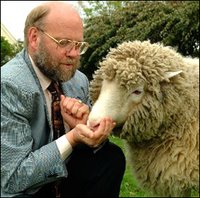
Just months after Korean science’s shooting star Hwang Woo-suk fell from grace after confessing that most of his research was actually fabricated, the international science community is shaken by another scandal surrounding one of the leading figures in cloning research.
Ian Wilmut, the English researcher who started the current frenzy about cloning when he stunned the world with Dolly, a cloned sheep, in 1996, admitted before an employment tribunal at the University of Edinburgh that he did not conduct the experiment after all. Now several parties are trying to take credit for the scientific breakthrough.
Professor Wilmut of Roslin Institute admitted this week that he only played a supporting role in Dolly’s creation, and that most of the credit should instead go to his colleague Keith Campell, who co-authored a paper about Dolly in the prestigious Nature magazine in 1997.








3 comments:
I'm not sure whether I'd characterize the Roslin revelations as fraudulent. (Though maybe you're thnking of a specific legal definition for this?)
Based on what's been reported to date, that there are important differences between Wilmut's and Hwang's conduct. If we want to draw parallels, then Wilmut is closer to Schatten than to Hwang, imo: he took credit for things he didn't do, and he didn't exercise the kind of oversight he should have, given his position.
More importantly, nobody's saying that Dolly wasn't cloned--which is (again, imo) a whole different level. . . and clearly fraud.
Yes, the title of the post is somewhat misleading at first blush -- Dolly was cloned, but not by Ian Wilmut. This is more an ethical issue in biomedical writing -- misrepresenting some one else's research as your own, fraudulent in that sense, like plagiarism.
This article is very misleading, probably because many people outside scientific world do not understand the concept of scientific experimentation and publishing. Profs. Wilmut and Campbell together in collaboration designed the experiments and came up with the basic principles and hypotheses that were tested, and skilled laboratory technicians performed the experiments. That somebody else did the actual hand-on experiment does not take away from neither of the leaders of the project. For example, nobody claims that the seamstresses who actually put together one of Versace's celebrated evening gowns are the persons who REALLY made the dress.
Post a Comment